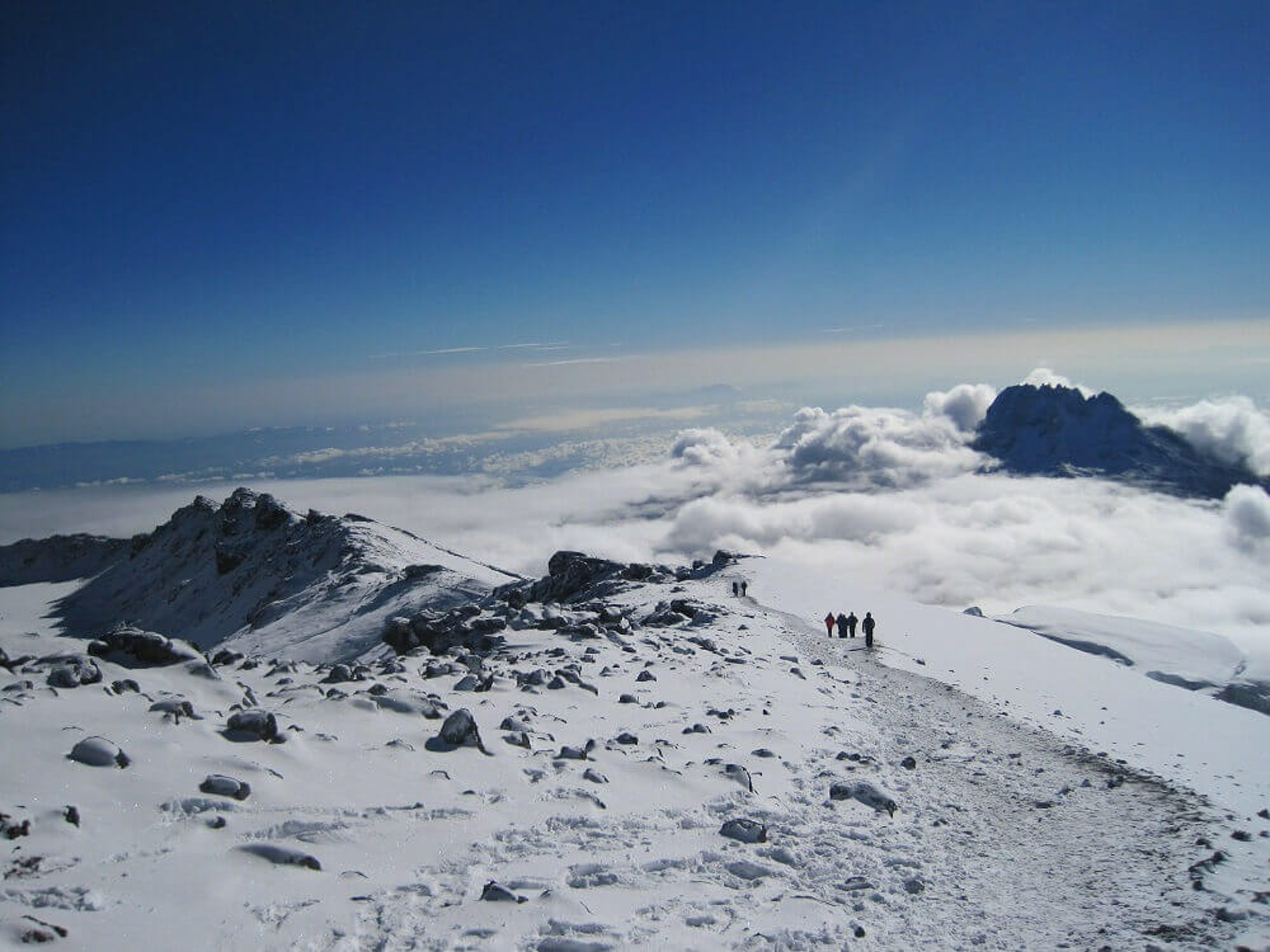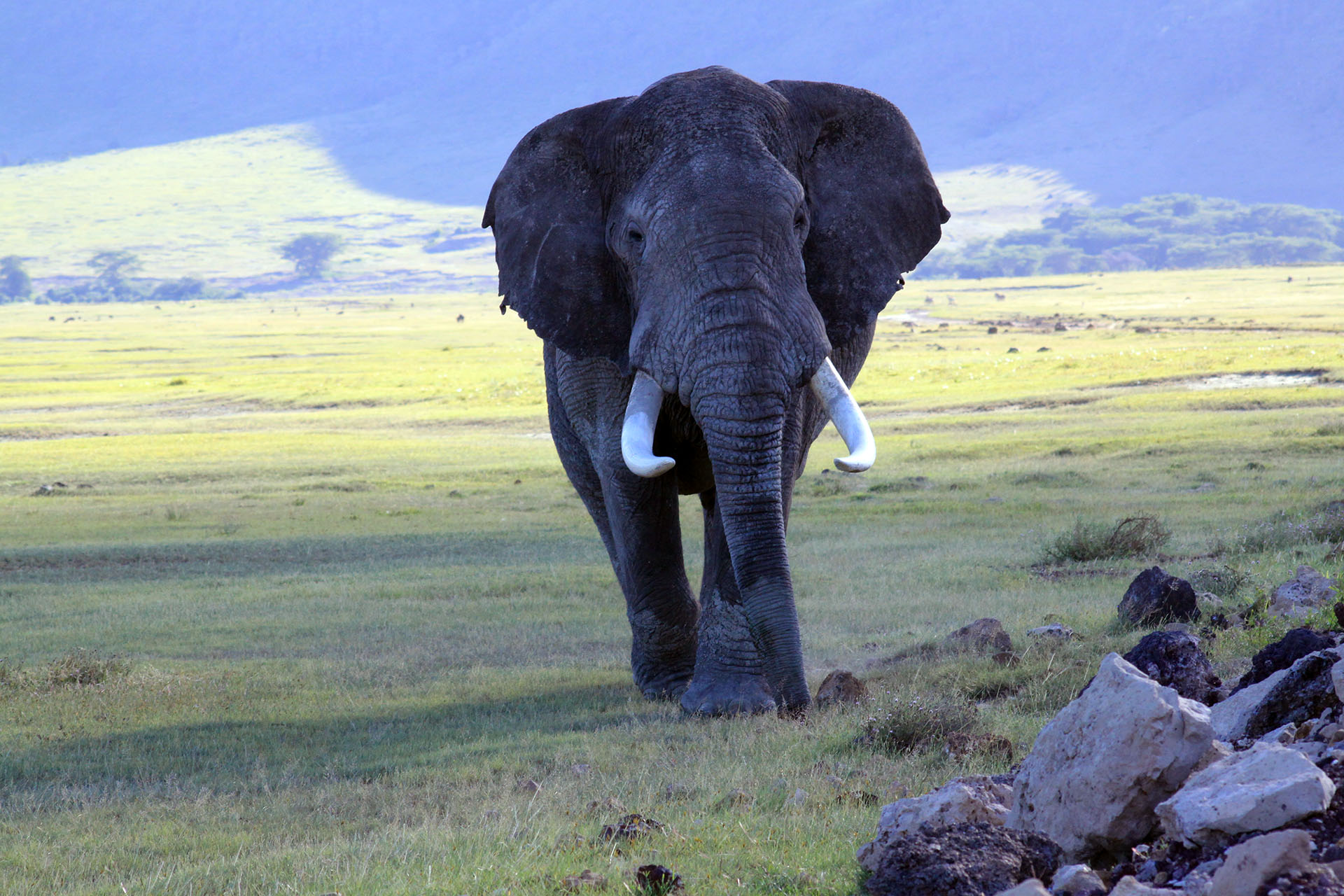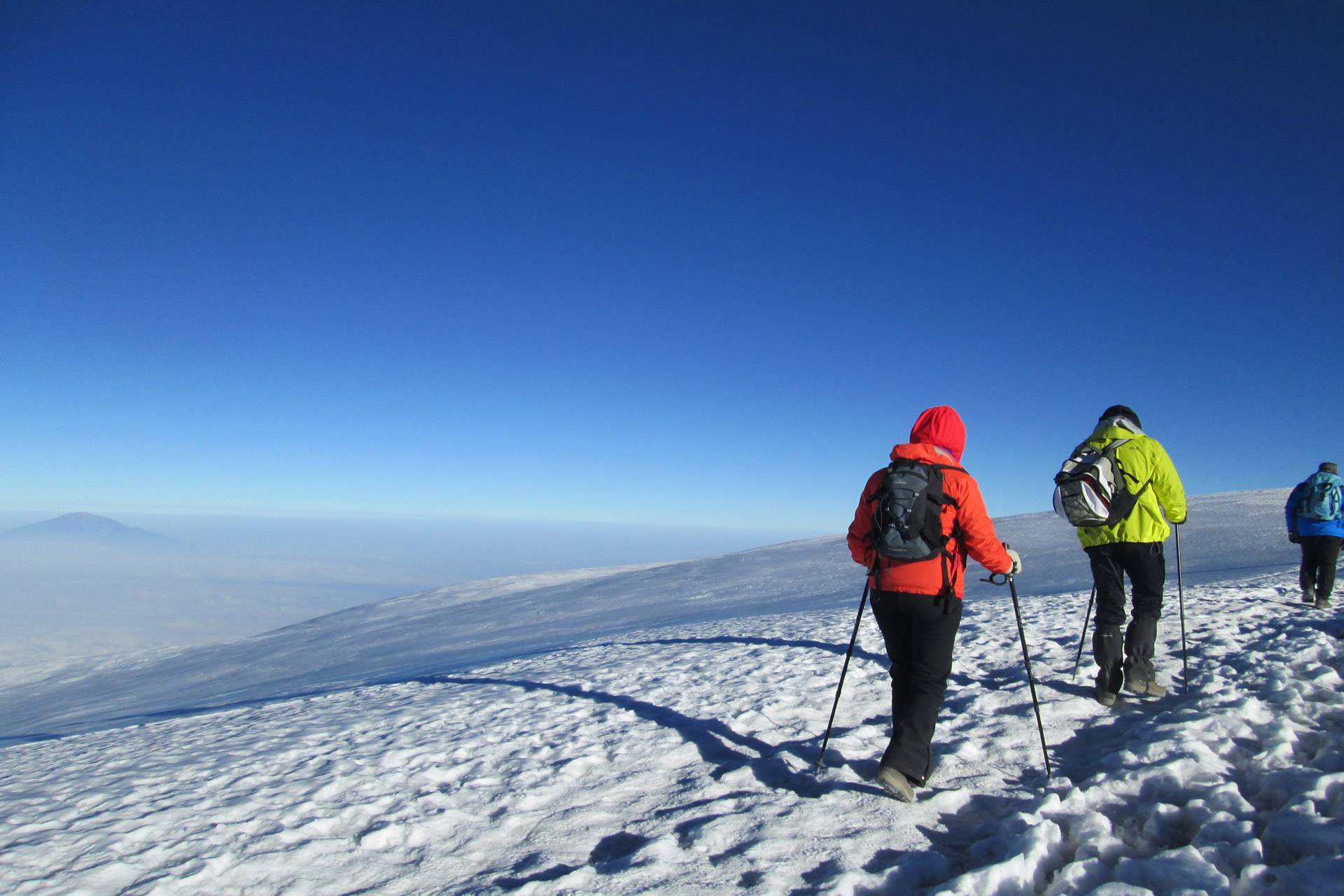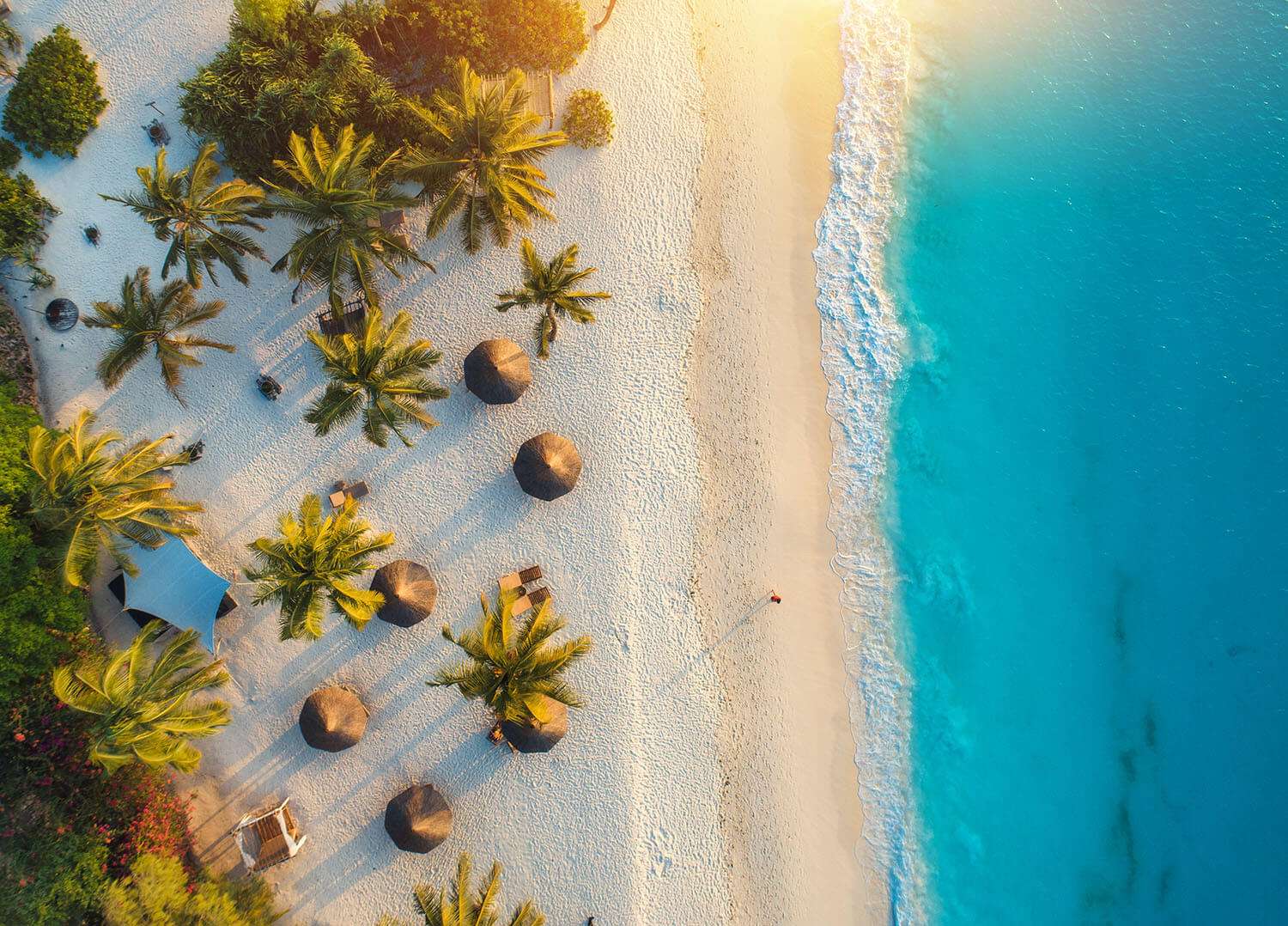
Weather on Mt. Kilimanjaro
What is the Weather on Kilimanjaro?
The weather on Mount Kilimanjaro is extremely diverse, often changing from hot to freezing cold within the same day. Unlike many places, the mountain does not experience dramatic seasonal shifts in temperature. Instead, conditions are determined by altitude and the time of day. At the base, average temperatures range between 21–27 °C, while at the summit of Uhuru Peak, nighttime temperatures can drop as low as –29 °C. Climbers must be ready for sunshine, rain, wind, cold, and even snow at any time.
Standing at 19,341 feet, Kilimanjaro is so massive that it creates its own weather systems. Being on the equator, it intercepts trade winds moving across the ocean. As these winds rise up the mountain’s slopes, they cool and release moisture, often resulting in rain on the lower slopes and snow near the summit. This makes the mountain’s weather highly unpredictable, with sudden shifts that can challenge even the most prepared hikers.
Rainfall on Kilimanjaro follows two main patterns. The long rainy season, from March to May, is driven by moist winds from the southeast. During this period, the southern slopes receive the most rainfall, while heavy snow often covers the summit. The short rains arrive in November from the northeast, bringing lighter, less intense showers, with most of the rainfall concentrated on the northern slopes.
Because of its proximity to the equator, Kilimanjaro’s temperatures do not vary greatly from season to season, but altitude changes make a big difference. As climbers move through the mountain’s five ecological zones, temperatures steadily drop. At the summit, which lies in the arctic zone, nighttime conditions can reach as low as –20 °F (–29 °C). For this reason, it’s essential for trekkers to be equipped with proper clothing and gear to handle both wet and freezing conditions, ensuring comfort and safety throughout the climb.
Kilimanjaro Weather through the Climate Zones
Kilimanjaro comprises five primary ecological climate zones — the Cultivation (Farmland) Zone, Rainforest Zone, Heather and Moorland Zone, Alpine Desert Zone, and the Arctic Zone
- Altitude Range: 2,600 to 6,000 ft. or 792 to 1,800 metres
- Days Temperature Range: 21 to 32 ℃ or 70 to 90 °F
- Nights Temperature Range: 4 to 15 ℃ to 40 to 60 °F
Zone 1 on Kilimanjaro is the Cultivation Zone. The altitude ranges from 792 m to 1,800 m. You can find plenty of human activities in this zone and see grazing livestock and small farm operations.
You can also find several rivers formed by the glacier run-off on the top of the mountain. Most of the porters and guides are from this part of Kilimanjaro.
- Altitude Range: 6,000 to 9,200 ft or 1,800 to 2,800 metres
- Days Temperature Range: 21 to32 ℃ or 70 to 90 °F
- Nights Temperature Range: 4 to 15 ℃ or 40 to 60 °F
The rainforest zone is the montane found encircling the whole mountain, also known as the rain forest. This forest is dense and wet and is home to many birds and other animal species.
Ever since the increase of human activity in the area, the big game has been rare, but plenty of monkeys and birds are around.
- Altitude Range: 9,200 to 11,000 ft or 2,800 to 3,350 metres
- Days Temperature Range: 10 to 27 ℃ 50 to 80 °F
- Nights Temperature Range: -1 to 15 ℃ or 30 to 60 °F
As you enter the Heather and Moorland zone, you’ll be greeted by the majestic views of giant heathers and tussock grasses, as well as the scrubby shrubs. When you ascend, the average temperatures drop.
You’ll also see giant lobelias and senecios, which have developed unique characteristics, allowing them to adapt to the drastic temperature changes of the place.
- Altitude Range: 13,200 to 16,500 ft or 4,020 to 5,030 metres
- Days Temperature Range: -12 to 15 ℃ or 10 to 60 °F
- Nights Temperature Range: -12 to 4 ℃ or 10 to 40 °F
The Alpine Desert Zone is barren and bleak. Thus, only the toughest plants exist in this area. You’ll often see tussocky grass and small hardy plants with only little flowers in this landscape.
Furthermore, rugged rock formations and scenic views mainly dominate this area.
- Altitude Range: 16,500 to 19,340 ft or 5,030 to 5,895 metres
- Days Temperature Range: -12 to 4 ℃ or 10 to 40 °F
- Nights Temperature Range: -26 to -7 ℃ to -15 to 20 °F
The Arctic zone is dry and freezing-cold during nighttime, opposed to the intense sunshine during the day. Due to the shortness of available oxygen at sea level, this part of Kilimanjaro is dominated by massive glaciers and towering boulders.
In this area of Mount Kilimanjaro, there are no animals or plants present except for lichens since the climate here is extremely cold. At nighttime, temperatures are typically below the freezing point.
During the day, as you set off to climb Kilimanjaro’s peak, there could be ice and snow underfoot. Also, expect the temperature to be bitterly cold even in the middle of the day.
Thus, it’s wise to bring sunscreen to protect your exposed body parts as the dry air can dehydrate you quickly. You’ll also need warm layers of clothing to keep your core temperature up.
Why Book With
VELAM TOURS & SAFARIS
- Trust And Safety
- Best Price Guarantee
- Smart Planning
- Licensed Operator
Book with Confidence, Travel with Experts
Booking your safari with Velam Tours & Safaris means traveling with a trusted partner who knows Tanzania inside and out. We combine local expertise, professional guides, and carefully planned itineraries to give you a smooth and memorable safari experience. With us, you don’t just see Tanzania – you feel it, through authentic encounters, comfortable stays, and personalized service that puts your needs first.
Our Tours in Tanzania
Discover Adventures Designed for Every Traveler
At Velam Tours & Safaris, we invite you to explore our top tours offered in Tanzania. From unforgettable wildlife safaris and mountain hiking adventures to cultural experiences and relaxing beach holidays, each journey is designed to give you the perfect balance of adventure, comfort, and discovery.
Testimonies
Words From Our Happy Clients
We have been receiving reviews from our served clients and We are rated 5/5 by customers. This honor is given to us by customers because we always remain committed to all our customers to do whatever is needed by them to make their safari fully satisfied.
Posted onVerified Incredible Safari Expereince We had the most incredible 7-day custom safari with Velam Safaris through the Serengeti and Northern Tanzania. From the very beginning, Adam and the entire Velam team went above and beyond to make our trip special. They carefully crafted the perfect itinerary based on our interests and desires, ensuring every detail was thought through.One of the highlights was having a professional photographer join us, capturing every moment so we could fully immerse ourselves in the experience. The team’s knowledge of the wildlife, landscapes, and local culture was outstanding, and everything about the trip felt seamless and well-coordinated.The accommodations and food throughout the journey were exceptional, making each day feel both adventurous and comfortable.We can’t recommend Velam Safaris highly enough. If you’re considering a safari in Tanzania, they will make your experience special.Posted onVerified Valence, Outstanding Safari Guide! We had the pleasure and honor of having Valence as our safari guide for seven days in Tanzania this August. This was my first safari and my husband’s fifth, and Valence was by far the most knowledgeable guide we have ever had. With over 12 years of experience, he was professional, full of energy, and always checking in on us with his friendly “Are you good?” He helped us spot an incredible range of wildlife, from zebras and giraffes to lions and cheetahs, and he seemed to know the habits of almost every plant and animal. He could even anticipate animal behavior, from predicting where a leopard would move during a hunt to finding the perfect spot for the wildebeest crossing in the Mara River. He even bought us some roasted bananas to try since we were curious about local cuisine, which made the experience feel even more authentic and special. We also ran into some car issues during the trip, which is quite common on safari, but Valence quickly identified the problem on the spot. As an experienced mechanic, he made the repairs at a nearby town without disrupting our itinerary much. Every day with him felt like a fascinating biology lesson, and thanks to Valence, our safari was both unforgettable and in the best of hands. We would highly recommend him to anyone planning a safari!Posted onVerified Best Guide - Valence: The Driver Who Made Our Tanzania Safari Unforgettable – Big Five, Perfect Views & Hakuna Matata In Tanzania, your driver is everything — guide, protector, storyteller. We were lucky to have Valence, with 12+ years of experience and a heart of gold. He showed us all the Big Five, river crossings, even lions hunting. He knew every road, avoided dust and breakdowns, and always found the perfect viewing spots. “Hakuna Matata,” he’d say, and we believed it. From day one he called us family — and treated us like it.Posted onVerified Felt like home in the midst of the jungle Being Single ladies we were taken care of so much and we felt so safe in the midst of the jungle with barely any network. Safari experience was smooth and so surprisingly magnificent.Adam who crafted our tour itinerary was in touch from day 1 till we landed back . Lolo and Lawrence our guides were nothing less than family :)Posted onVerified Exceptional Safari Experience! Velam Safaris delivered an outstanding safari adventure! From seamless communication to expert-guided game drives, every moment was exceptional. Luxurious accommodations, attentive staff, and a commitment to sustainability set them apart. Highly recommend for an unforgettable safari experience!Posted onVerified Unforgettable Trip - Organized by Adam This trip was absolutely incredible! A huge thanks to Adam for organizing everything so flawlessly. From the very beginning, Adam was incredibly helpful and responsive, answering all my questions and making sure everything was perfectly tailored to our interests.Posted onVerified Exceptional 5-Day Safari with Velam Safaris Velam Safaris provided an outstanding 5-day safari experience. Our knowledgeable guide made every moment memorable with incredible wildlife sightings and insightful commentary. The accommodations were luxurious, and the opportunity to connect with local communities added depth to the journey. Highly recommended for an unforgettable adventure in the heart of Africa.Posted onVerified A Fantastic Adventure with Velam Safaris: My 5-Day Tanzania Safari Review I went on a safari trip with Velam Safaris in Tanzania for 5 days, and it was amazing. Everything was well planned, and the trip was fantastic from start to finish.The best part was seeing all the animals. Our guide took us on drives through Serengeti National Park and Ngorongoro Conservation Area. We saw lions, elephants, rhinos, and many other animals in their natural homes. It was so cool to be up close to them.Our places to stay were really nice too. We stayed in comfy tents and cozy lodges. Waking up to the sounds of animals and eating tasty meals outside was so nice.What I liked most about Velam Safaris is that they care about the environment. Our guide talked about why it's important to protect nature, and I thought that was great.Overall, I had an awesome time with Velam Safaris. If you want to go on a safari in Tanzania, I definitely recommend them. Thanks, Velam Safaris, for an unforgettable adventure!Verified by TrustindexTrustindex verified badge is the Universal Symbol of Trust. Only the greatest companies can get the verified badge who has a review score above 4.5, based on customer reviews over the past 12 months. Read more




